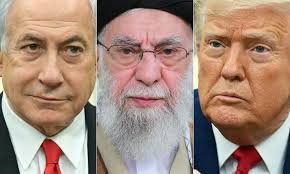US Launches Pre‑Dawn Strike on Iran’s Nuclear Facilities in Historic Escalation
June 22, 2025 – By [Roxx News]
In a swift and unprecedented military move, the United States executed a coordinated airstrike on Iran’s nuclear infrastructure in the early hours of June 22. Code‑named Operation Midnight Hammer, the assault targeted three critical installations—Fordow, Natanz, and Isfahan—using advanced bunker-buster munitions and cruise missiles in a high-stakes escalation that risks drawing the region deeper into conflict.
1. Targets and Ordnance
According to U.S. military officials, the strike involved a fleet of seven B‑2 Spirit stealth bombers, which launched fourteen 30,000‑pound GBU‑57 Massive Ordnance Penetrator (MOP) bombs, alongside a barrage of Tomahawk cruise missiles deployed from an Ohio‑class submarine. The MOP is the largest conventional bomb in the U.S. arsenal, designed to penetrate deeply buried facilities—particularly the fortified Fordow plant, which sits inside a mountain.
2. Execution and Surprise
The strike commenced around 2:30 a.m. IRST (11:00 p.m. UTC, June 21), dubbed a “surprise attack” involving multi-layered countermeasures: electronic interference, decoys, and stealth tactics. U.S. sources report no Iranian defense systems were able to intervene . President Trump, in a statement, called the operation “very successful” and stressed that all U.S. aircraft exited Iranian airspace safely.
3. Damage Assessment
The Pentagon asserts that Natanz has been destroyed, while Fordow and Isfahan suffered major damage. Satellite imagery from Maxar Technologies suggests significant harm at Fordow and the uranium conversion facilities at Isfahan, though the subterranean cascade halls appear largely intact nypost. A thorough damage evaluation is still underway.
4. U.S. Motives and Objectives
U.S. leaders described the operation as a strategic effort to “significantly impair” Iran’s nuclear capabilities, though not to overthrow the regime euronews.Administration officials emphasized the attack was a pre‑emptive measure, coming after stalled negotiations and “decisive” Israeli strikes . The decision rested with President Trump, though Congress was reportedly notified only post-strike—a move fueling debate over executive war powers.
5. Iranian and Regional Reaction
Iran condemned the strike as a “criminal act” and a violation of international law, warning of “everlasting consequences” and pledging retaliation against U.S. assets in the Middle East and global shipping interests. They also emphasized that no off-site radiation leakage had been detected.
6. International Response
World leaders have reacted with alarm. China, Russia, and the UN Secretary-General António Guterres called for immediate de-escalation, citing fears of nuclear contamination and a broader war . European powers expressed deep concerns over the circumvention of diplomatic channels.
7. Domestic U.S. Fallout
The strike has ignited bipartisan controversy in Washington. Republican hawks praised the strong show of force, while Democrats and some Republicans criticized the move as constitutionally unfettered and dangerously escalatory . Debates over the War Powers Resolution and congressional oversight are expected to intensify.
8. Broader Middle East Implications
The U.S. action aligns with a recent pattern of Iranian–Israeli military exchanges. Israel previously launched strikes in early June—Operation Rising Lion—using a mix of drone sabotage and air raids on nuclear and missile infrastructure. Iran retaliated with missile and drone attacks on Israel, and now Tehran has threatened reprisals against American personnel and allies .
9. Economic and Security Shockwaves
The attack pushed oil markets upward and moved Western governments—like Australia—to advise citizens of potential escalation. Concerns over chokepoint security, especially the Strait of Hormuz, remain high .
10. Path Forward
President Trump framed the strike as a catalyst for renewed diplomacy, but warned that additional use of force would follow if Iran escalates . Tehran insists its nuclear ambitions are strictly peaceful and has appealed for global backing to hold Washington accountable.
Operation Midnight Hammer
marks the most significant direct U.S. strike on Iran since the 1979 revolution. Utilizing the largest conventional bombs in history, the U.S. aimed to cripple Iran’s most fortified nuclear sites in Fordow, Natanz, and Isfahan. While the Pentagon reports major damage, full assessments remain pending. The attack signals U.S. readiness to escalate beyond covert support for Israel’s campaign and has ignited new tensions—but also reopened avenues for diplomacy. At home, legal and political battles loom over presidential war powers. Abroad, the world watches with apprehension as Iran vows to retaliate and regional security hangs in the balance.
Heightened vigilance remains essential. The next few weeks will likely determine whether diplomacy holds or this episode spirals into an expanded Middle Eastern war.

